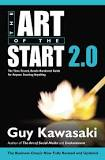 |
The Art of the Start |
I use a top-ten list format for all my speeches, and I would love to begin this book with a top-ten list of the most important things an entrepreneur must accomplish. However, there aren't ten there are only five,
Great Ideas for Starting Things
- Make Meaning. The best reason to start an organization is to make meaning - to create a product or service that makes the world a better place. So your first task is to decide how you can make meaning.
- Make Mantra. Forget mission statements; they are long, boring, and irrelevant. No one can ever remember them - much less implement them. Instead, take your meaning and make a mantra out of it. This will set your entire team on the right course.
- Get Going. Start creating and delivering your product or service. Think soldering irons, compilers, hammers, saws, and AutoCAD - whatever tools you use to build products and services. Do not focus on pitching, writing, and planning.
- Define Your Business Model. No matter what kind of organization you are starting, you have to figure out a way to make money. The greatest idea, technology, product, or service is short-lived without a sustainable business model.
- Weave a Mat (Milestones, Assumptions, and Tasks). The final step is to compile three lists:
- Major milestones you need to meet
- Assumptions that are built into your business model;
- Tasks you need to accomplish to create an organization. This will enforce discipline and keep your organization on track when all hell breaks loose - and all hell will break loose....
Make Meaning
I have never thought of writing for reputation and honor. What I have in my heart must come out; that is the reason why I compose. - Ludwig van Beethoven
Many books about entrepreneurship begin with a rigorous process of self-examination, asking you to determine if you are truly up to the task of starting an organization. Some typical examples are:
- Can you work long hours at low wages?
- Can you deal with rejection after rejection?
- Can you handle the responsibility of dozens of employees?
The truth is, it is impossible to answer questions like this in advance, and they ultimately serve no purpose. On the one hand, talk and bravado are cheap. Saying you’re willing to do something doesn’t mean that you will do it. On the other hand, realizing that you have doubt and trepidation doesn’t mean you won’t build a great organization. How you answer these questions now has little predictive power regarding what you’ll actually do when you get caught up in a great a great idea. The truth is that no one really knows if he is an entrepreneur until he becomes one - and sometimes not even then. There really is only one question you should ask yourself before starting any new venture: Do I want to make meaning?
Meaning is not about money, power, or prestige. Itʼs not even about creating a fun place to work. Among the meanings of “meaning” are to:
- Make the world a better place.
- Increase the quality of life.
- Right a terrible wrong.
- Prevent the end of something good.
Goals such as these are a tremendous advantage as you travel down the difficult path ahead.If you answer this question in the negative, you may still be successful, but it will be harder to become so because making meaning is the most powerful motivator there is. Its taken me twenty years to come to this understanding.
In 1983, when I started in the Macintosh Division of Apple Computer, beating IBM was our reason for existence. We wanted to send IBM back to the typewriter business holding its Selectric typewriter balls. In 1987, our reason for existence became beating Windows and Microsoft. We wanted to crush Microsoft and force Bill Gates to get a job flipping fish at the Pike Place. In 2004, I am a managing director in an early-stage venture capital firm called Garage technology Ventures. I want to enable people to create great products, build great companies, and change the world. The causation of great organizations is the desire to make meaning. Having that desire doesn’t guarantee that you’ll succeed, but it does mean that if you fail, at least you failed doing something worth while.
Make Mantra
Close your eyes and think about how you will serve your customers. What kind of meaning do you see your organization making? Most people refer to this as the “Why” or mission statement of an organization. Crafting a mission statement is usually one of the first steps entrepreneurs undertake. Unfortunately, this process is usually a painful and frustrating experience that results in exceptional mediocrity. This is almost inevitable when a large number of people are commissioned to craft something designed to make an even larger number of people (employees, shareholders, customers, and partners) happy.
The fundamental shortcoming of most mission statements is that everyone expects them to be highfalutin and all-encompassing. The result is a long, boring, commonplace, and pointless joke.
In The Mission Statement Book,Jeffrey Abrams provides 301 examples of mission statements, which demonstrate that companies are all writing the same mediocre stuff. To wit, this is a partial list of the frequency with which mission statements in Abramsʼs sample contained the same words:
- Best ..............................94
- Communities...............97
- Customers..................211
- Excellence.....................77
- Leader........................ 106
- Quality........................169
Fortune (or Forbes, in my case) favors the bold, so I’ll give you some advice that will make life easy for you: Postpone writing your mission statement. You can come up with it later when you’re successful and have lots of time and money to waste. (If you’re not successful, it wonʼtmatter that you didn’t develop one.Instead of a mission statement and all the baggage that comes with it, craft a mantra for your organization. The definition of mantra is:A sacred verbal formula repeated in prayer, meditation, or incantation, such as an invocation of a god, a magic spell, or a syllable or portion of scripture containing mystical potentialities.
What a great thing a mantra is! How many mission statements evoke such power and emotion?The beauty of a mantra is that everyone expects it to be short and sweet. (Arguably, the worldʼs shortest mantra is the single Hindi word Om.) You may never have to write your mantra down, publish it in your annual report, or print it on posters. Indeed, if you do have to “enforce” your mantra in these ways, its not the right mantra. Following are five examples that illustrate the power of a good mantra:
- Authentic athletic performance (Nike).
- Fun family entertainment (Disney).
- Rewarding everyday moments (Starbucks).
- Think (IBM).
- Winning is everything (Vince Lombardiʼs Green Bay Packers)
Compare the Starbucks mantra, “Rewarding everyday moments,” to the company’s mission statement, “Establish Starbucks as the premier purveyor of the finest coffee in the world while maintaining our uncompromising principles while we grow.” Which is more memorable? Imagine that someone asks your parents or your organizations receptionist what you do. Can it get any better than a three-word mantra such as “Authentic athletic performance”? A final thought on mantras: Don’t confuse mantras and tag lines. A mantra is for your employees; its a guideline for what they do in their jobs. A tag line is for your customers;its a guideline for how to use your product or service. For example, Nikeʼs mantra is “Authentic athletic performance.” Its tag line is “Just do it.
Download full article for more...
Enjoy this article? Feel free to share your comment, idea or opinion in the comment section
Related Articles

|
Don’t Do Goals? Then See a PriestThere are many benefits to having a structure that provides us with a way of making sense of our world and bringing fulfillment and achievement. Yet people have real issues with setting and maintaining meaningful goals. If you find goal-setting an issue, then help is at hand! Instead of thinking abo [Read more]
|
Posted: 13 years ago |

|
Rethinking Training and DevelopmentA typical human resource professional confronts a myriad of challenges daily and chief among them is convincing senior management on the need to invest in staff training and development. This is somewhat surprising because employees cannot be expected to perform their duties without having the requi [Read more]
|
Posted: 7 years ago |

|
How to Reinvent Yourself To Be The Best You Can BeChange, they say, is the one thing that is constant. Change is the only thing that keeps happening, and it happens by the millisecond. However, since there are certain things we can’t stop from changing, like our age and bodies, there are things we wish we could change, but don’t know ho [Read more]
|
Posted: 7 years ago |


